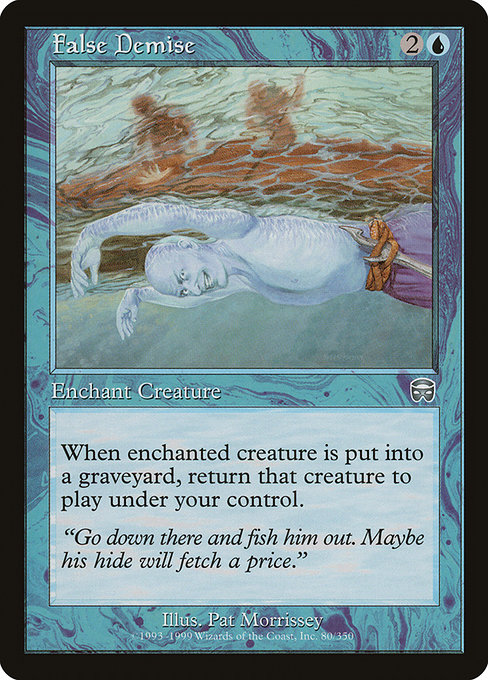
Image courtesy of Scryfall.com
False Demise Ignites Crossover Demand from Non-MTG Collectors
Blue enchantments have a way of slipping into the spotlight when magic happens outside the battlefield. False Demise, a Mercadian Masques treasure from the late 1990s, is a perfect case study in how a compact, strategic card can spark interest far beyond its original audience. With a mana cost of {2}{U} and an aura framework—“Enchant creature” and a powerful, though situational, upside—the card invites both nostalgic players and design enthusiasts to read its flavor text, study its art, and imagine it in a wider pop-cultural context 🧙♂️. If you’re someone who collects art prints, vintage gaming artifacts, or clever blue tricks, this little uncommon has a surprising way of crossing over into everyday fandom, trading cards for coffee-table talk, and even inspiring new merchandise ideas in the modern era 🔥.
Mercadian Masques sits at a turning point in MTG history: it’s the era when the game started to mature toward faster formats and more intricate card interactions, while still carrying that late-90s whimsy. False Demise captures a moment when blue’s control toolkit could suddenly become personal and tactile. The card’s text—“Enchant creature. When enchanted creature dies, return that card to the battlefield under your control.”—is both elegant and practical. It doesn’t simply stall; it creates a short-lived, yet meaningful, tempo swing: your opponent’s creature dies, and suddenly you rehang the creature on your side. The play pattern invites players to think in terms of “sacrifice and recapture” rather than pure value engines, a mindset that translates well to deck-building puzzles in casual play and in legacy-like formats where retro cards find fresh life ⚔️.
From Tabletop Tactics to Tabletop Treasures
For crossover audiences, the charm lies in three intersecting threads: the art and lore, the mechanical elegance, and the rarity dynamics. Pat Lewis’s art—captured here with a crisp early frame—presents a blue spell that feels pedagogical, almost like a study in “how to leverage enemy resources.” The flavor text, “Go down there and fish him out. Maybe his hide will fetch a price,” taps into the archetypal fantasy raconteur’s voice—a wink to the raiders of old-school dungeons and the modern collector’s sensibilities. It’s a lyric that can draw in readers who love pirate lore, treasure hunts, and stories where cunning and wit triumph over brute force 🎨.
“Go down there and fish him out. Maybe his hide will fetch a price.”
From a gameplay perspective, False Demise is a reminder of why aura cards aren’t merely “enchantment with a condition.” They’re a barometer of timing and risk. The card rewards patient planning: you envision a turn where your enchanted creature dodges the worst of removal, only to step back into play under your control when it inevitably dies. That moment—when the aura’s effect flips the script and your opponent’s attention shifts—feels cinematic, a micro-drama that fits neatly into the MTG storytelling tapestry. This emotional resonance is a cornerstone of crossover appeal; it gives non-MTG collectors a narrative hook to latch onto, even if they aren’t drafting or tournament playing themselves 🧙♂️.
Design, Demand, and the Gate to Other Worlds
In the broader market, False Demise sits among other blue, recursion-oriented auras that remind players of MTG’s long-running love affair with card reanimation and control. While its current price point is modest—about $0.26 for the non-foil, with foils hovering higher—the value isn’t just about dollars. It’s about the card’s storytelling potential and its portability as a talking piece. The same blue mana that powers your countermagic and bounce spells can also power your imagination: a card that speaks to fans of classic art, mid-90s game design, and the hobby’s modern curators who love turning vintage cards into conversation starters for display shelves, sleeves, or desk-side inspiration 💎.
Collectors who enjoy crossovers with pop culture will appreciate how a card from Mercadian Masques—one printed long before the current “nostalgia era” of MTG—continues to surface in modern conversations about value, provenance, and playability. The card’s reprint status in MMQ, combined with its recurring presence in non-tournament circles, makes it a prime example of how older designs stay relevant. It’s the kind of piece that can lead to side discussions about OA (old artwork) prints, variant frames, and the ways we curate our favorite moments from the game’s storied past 🔥.
- Gameplay value: A compact, tempo-friendly aura that rewards thoughtful tax and recapture strategies in older formats.
- Artistic appeal: A blue, painterly cover that resonates with fans of 1990s MTG illustration and the golden era of card design.
- Crossover potential: A gateway card for non-MTG collectors who love stories, treasure themes, and vintage aesthetics.
As the hobby grows, products that blend MTG nostalgia with everyday lifestyle become more common. The synergy is not about turning a card into a gadget—but about giving fans a tangible way to celebrate the MTG multiverse in their daily lives. If you’re building a display or styling a collecting desk, small, elegant items like the Neon phone case with card holder—handsome, practical, and a nod to the age of metallic finishes—offer a discreet bridge between worlds. The product page itself is a reminder that MTG culture thrives where collector culture and utility intersect 🧙♂️💎.
For readers who want to show off their fan pride while keeping their devices organized, this blend of retro card lore and contemporary design is hard to beat. The non-MTG collector’s eye can still recognize the cleverness of a card that turns a death into a return, and that same eye can spot a stylish case that keeps your travel-sized deck of memories protected. It’s the little intersections—the aura that enchants, the art that lingers, the case that carries—that keep the crossover flame alive, even as new sets rise and old ones settle into the background 🔥🎲.